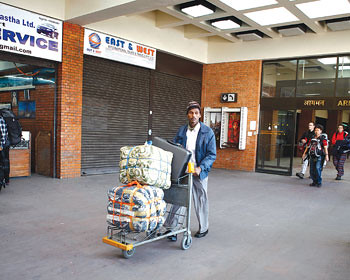Growth in remittance is an indication of the abject political and economic state of Nepal

BIKRAM RAI
Everyday about a thousand men and women fly out of Kathmandu to India, the Gulf, South Korea, Malaysia, US, and Europe where they join four and a half million fellow Nepali workers.
These are the men and women who keep the country’s limping economy?afloat by contributing a quarter - $4 billion - of our annual GDP. The actual figures could be three times higher than the official figure since almost 70 per cent of remittance comes through informal channels (specially from India) and large numbers of illegal workers are not accounted for.
Remittance boosts individual families’ income levels and allows them access to services like health and education. It leads to increased consumption which is good for local businesses. And when the government is having a hard time attracting foreign investments, remittance acts as an important source of external financing along with debt, equity, and development aid.
However, growth in remittance is an indication of the abject political and economic state of Nepal. According to the World Bank, remittances (unlike private capital flows) tend to rise when the recipient country experiences an economic slump bought on by a financial crisis or political stalemate. As times get harder here, migrants are sending more cash to help out their families and friends.
We have also failed to utilise the large amounts of remittance for investments or to generate capital. Around 85 per cent of money sent home by migrant labourers is spent on consumption and many families don’t have any long-term savings. Rising demand for imported consumer products like electrical goods, cars, and bikes means that for every dollar earned, 25 cents goes right back out. Two per cent of remittance goes into real estate, but investments in businesses, infrastructure or the industrial sector is almost zero.
The other downside of a remittance-reliant economy is its effect on our labour force. Not only are we letting go of thousands of young Nepalis every year, but families who depend on money from relatives abroad are losing their motivation to work or do business. Those who have brothers or sisters working outside the country increasingly believe foreign employment is their only way out. To make things worse the state, foreign investors, and the private sector are hesitant to invest in regions where out-migration is high due to unreliable workforce.
It’s high time the government revamped its remittance policies and started using the dollars coming from abroad to generate jobs at home and stem the mass exodus. Money from remittance can be used for micro-investments and micro-financing in sectors like agriculture and trading. Big investments in manufacturing might not be feasible, but small investments would serve as baby steps in increasing entrepreneurship and engagement of the private sector in Nepal.
Surveys show that returnee migrant workers and their families who might be interested in investing or starting their own business usually lack the acumen and skills. Understanding their motivation, developing capacity, and equipping them with the necessary skills should therefore be a top priority for the state. Only then can it influence their consumption and investment habits.?
As 30 per cent of young Nepali men work outside, more and more women are managing households on their own. They should be the focus of government policies. If women with remittance funds are encouraged to start businesses through incentives like tax subsidies, they will not only create employment for themselves but also others in the community.